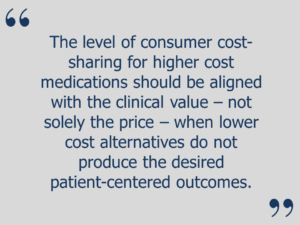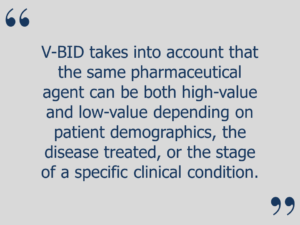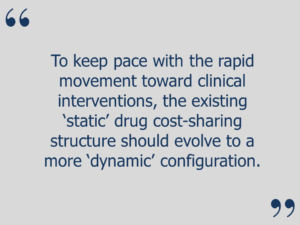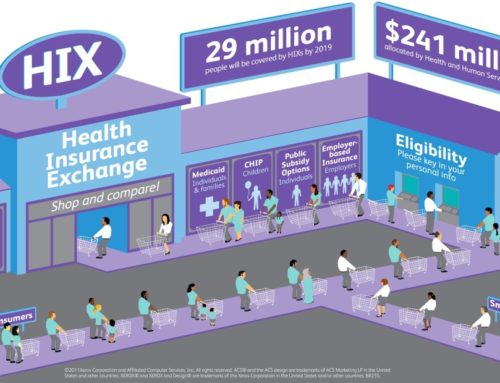A ‘Dynamic’ Approach to Consumer Cost-Sharing for Prescription Drugs
Access to, and levels of spending on, prescription drugs has become an important public policy issue. Given the significant individual and population health gains that result from the appropriate use of prescription drugs, as well as the fiscal concerns pertaining to the escalation of health care expenditures, the development and implementation of patient-centered solutions that allow access to medications at an affordable cost are of critical importance.
 One common strategy that health care purchasers employ to control pharmaceutical spending is to increase consumer cost-sharing. This trend — seen for nearly all drugs across all formulary tiers — has proceeded regardless of the clinical benefit provided by a specific drug, with cost-sharing increasing as rapidly for high-value drugs (e.g., included in evidence-based guidelines) as for drugs deemed unnecessary or potentially harmful. 1 As consumers are asked to pay a greater proportion of their medication expenses, cost-related non-adherence is an important and growing problem. A robust body of peer-reviewed evidence demonstrates that cost-related non-adherence exists for high-value medical services across the entire episode of clinical care, including clinician visits, diagnostic tests, and especially prescription medications.234 Nearly one in five insured adults report going without needed care due to cost.5 Sub-optimal use of evidence-based services results in poor patient-centered outcomes and, in some scenarios, higher expenditures for both the patient and the third-party payer.
One common strategy that health care purchasers employ to control pharmaceutical spending is to increase consumer cost-sharing. This trend — seen for nearly all drugs across all formulary tiers — has proceeded regardless of the clinical benefit provided by a specific drug, with cost-sharing increasing as rapidly for high-value drugs (e.g., included in evidence-based guidelines) as for drugs deemed unnecessary or potentially harmful. 1 As consumers are asked to pay a greater proportion of their medication expenses, cost-related non-adherence is an important and growing problem. A robust body of peer-reviewed evidence demonstrates that cost-related non-adherence exists for high-value medical services across the entire episode of clinical care, including clinician visits, diagnostic tests, and especially prescription medications.234 Nearly one in five insured adults report going without needed care due to cost.5 Sub-optimal use of evidence-based services results in poor patient-centered outcomes and, in some scenarios, higher expenditures for both the patient and the third-party payer.
An important aim of a multi-tier prescription drug formulary — largely driven by fiscal constraints — is to encourage patients to use effective, lower cost medications. Such approaches to pharmaceutical management (e.g., generic substitution, prior authorization) have been utilized for decades with varying effects on spending. A recommendation that patients are initially prescribed lower cost medication(s) is a reasonable population health strategy, given that a first-line medication will often be effective and, given the relative lower cost, will be considered high-value for that patient and for the payer. However, it is not uncommon that certain patients cannot be prescribed (e.g. due to drug allergy or drug-drug interaction) or do not respond to first-line, lower cost medications. In these frequent clinical scenarios, an individual will require a substitute or an additional drug to achieve patient-centered clinical outcomes. In these situations, the first-line drug is no longer high-value, and a clinically indicated, higher cost alternative becomes a higher value choice. Therefore, the level of consumer cost-sharing for higher cost medication should be aligned with the clinical value — not solely the price — when lower cost alternatives do not produce the desired patient-centered outcomes.
 The concept of aligning patients’ out-of-pocket costs — such as copayments, co-insurance, and deductibles — with the value of health care services is the basic premise of Value-Based Insurance Design (V-BID).6 This approach to designing benefit plans recognizes that specific health services have different levels of value. Thus, V-BID programs are designed with the tenets of ‘clinical nuance’ in mind, which recognize that 1) medical services differ in the amount of health produced, and 2) the clinical benefit derived from a specific service depends on the consumer using it, as well as when, where, and by whom the service is provided. V-BID takes into account that the same pharmaceutical agent can be both high-value and low-value depending on patient demographics, the disease treated, or the stage of a specific clinical condition.
The concept of aligning patients’ out-of-pocket costs — such as copayments, co-insurance, and deductibles — with the value of health care services is the basic premise of Value-Based Insurance Design (V-BID).6 This approach to designing benefit plans recognizes that specific health services have different levels of value. Thus, V-BID programs are designed with the tenets of ‘clinical nuance’ in mind, which recognize that 1) medical services differ in the amount of health produced, and 2) the clinical benefit derived from a specific service depends on the consumer using it, as well as when, where, and by whom the service is provided. V-BID takes into account that the same pharmaceutical agent can be both high-value and low-value depending on patient demographics, the disease treated, or the stage of a specific clinical condition.
The ongoing transformation to ‘precision’ preventive care, diagnostics, and therapies provides a clear impetus to include clinical nuance in setting prescription drug cost-sharing levels. To keep pace with the rapid movement toward targeted clinical interventions, the existing ‘static’ drug cost-sharing structure should evolve to a more ‘dynamic’ configuration. Such a transition to a more nuanced approach is supported by several factors, including: 1) an increasing number of evidence-based protocols recommending specific genetic markers, companion diagnostics, or patient-specific factors; and 2) the natural history of many chronic conditions often necessitates the use of multiple evidence-based therapies to achieve desired clinical outcomes. Clinical scenarios often require a patient to take multiple drugs simultaneously and/or cycle through multiple drugs to effectively treat a specific condition.
The implementation of these transformative, yet intuitive, design features are often at odds with the fact that: 1) most health plans require certain steps be performed by a patient before access to additional or more expensive therapies is granted (i.e., step-edit); and 2) in many clinical scenarios, a patient will face higher cost-sharing for recommended treatments when first-line therapy is not indicated or does not work. When faced with clinically appropriate alternatives beyond first-line agents, a patient is often unable to escape higher out-of-pocket costs for essential medications.
Thus, an individual enrolled in a multi-tier formulary who perfectly complies with the treatment steps required by his/her health plan (aka “The Good Soldier” – read below), but cannot safely take or does not respond to first-line therapy, faces ‘double jeopardy’ in that 1) their individual clinical circumstance does not permit the benefit from a lower cost agent, and 2) the recommended second-line therapy often has substantially higher consumer cost-sharing. An unintended outcome of these commonly employed prescription drug programs is that the sickest patients are often those who face the highest financial burdens. A growing body of evidence concludes that increases in consumer cost-sharing in these vulnerable patient cohorts leads to a reduction in the use of essential services, worsens health disparities, and in some cases leads to greater costs for the patient, the health plan, and society.7 To mitigate these issues and prevent patients from being penalized for circumstances beyond their control, innovative solutions are warranted.
in that 1) their individual clinical circumstance does not permit the benefit from a lower cost agent, and 2) the recommended second-line therapy often has substantially higher consumer cost-sharing. An unintended outcome of these commonly employed prescription drug programs is that the sickest patients are often those who face the highest financial burdens. A growing body of evidence concludes that increases in consumer cost-sharing in these vulnerable patient cohorts leads to a reduction in the use of essential services, worsens health disparities, and in some cases leads to greater costs for the patient, the health plan, and society.7 To mitigate these issues and prevent patients from being penalized for circumstances beyond their control, innovative solutions are warranted.
A ‘Dynamic’ Approach to Consumer Cost-Sharing: “Reward the Good Soldier ”
The rapid expansion of precision medicine has important implications for how drug management strategies should be implemented. As treatment recommendations are increasingly based on individual patient characteristics (genotypic or phenotypic) and/or the natural history/progression of disease, a clinically nuanced drug benefit that acknowledges multiple treatment options for a single condition or patient is warranted. Reward the Good Soldier is one such ‘dynamic’ design. The fundamental principle of this concept is to lower consumer cost-sharing for clinically indicated services for those patients who diligently follow the required steps for their specific condition, but need an alternative treatment option.
The essence of the Reward the Good Soldier design strongly commits to existing policies that encourage first-line use of lower cost therapies when clinically indicated. The implementation is similar to commonly used step-therapy programs, with the important difference that consumer cost-sharing levels are lowered for the second-line, (or third…) treatment alternative, only when the first-line therapy is contraindicated or is deemed ineffective at achieving the desired clinical outcome. While an existing step-edit program is a common framework on which to build a Reward the Good Soldier design, the use of a step-edit program is neither a prerequisite nor required element to implement this dynamic benefit approach.
The precision medicine movement is founded on the principle that the health benefits provided by a particular service depend on the specific clinical circumstances around its use. The use of targeted and sequential therapies in a growing number of clinical circumstances supports the elimination of an archaic prescription drug cost-sharing model that does not share this fundamental premise. In its place, the implementation of a ‘dynamic’ approach to drug cost-sharing that enhances access to effective, clinically appropriate therapies, improves patient outcomes, aligns with quality-driven provider initiatives, and promotes efficient expenditures for the payer is clearly warranted. Such innovation is an important and necessary step forward if the goal of “Right drug, Right person, Right time, Right price” is to be ultimately achieved.
References
1. Chernew M. J Gen Int Med. 2010;25;243-8.
2. Goldman D. JAMA. 2007;298;61-9.
3. Trivedi NEJM. 2008;358:375-383.
4. Trivedi A. NEJM. 2010;362(4):320-8.
5. Kaiser Family Foundation/New York Times Medical Bills Survey http://kff.org/health-costs/press-release/new-kaisernew-york-times-survey-finds-one-in-five-working-age-americans-with-health-insurance-report-problems-paying-medical-bills/ (accessed May 25, 2016).
6. Chernew M. Health Affairs. 2007;26(2):195-203.
7. Chernew M. J Gen Int Med. 2008;23(8):1131-6.
For more information on V-BID and specialty pharmaceuticals, please view these additional resources.
Specialty Pharma White Paper Good Soldier Whiteboard Video

Funding for this V-BID Center Brief was provided by the National Pharmaceutical Council.







